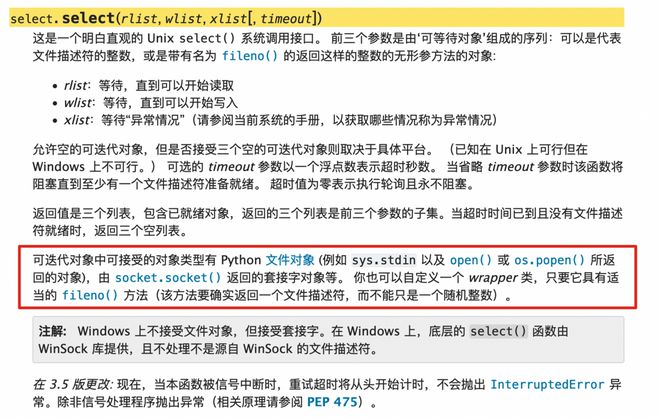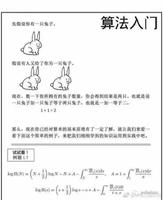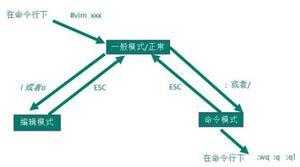为什么 python 的 select 分不清文件的可读可写?
使用 python 的 select.select
为了简单,就先没有使用 socket,而是使用 file
因为官方文档中说,可以是 python 文件对象,也可以是 socket 套接字
? 但是发现了和预期不符合的情况:
from pathlib import Pathimport select
from loguru import logger
BASE_DIR = Path(__file__).resolve().parent
with open(BASE_DIR/'run.log', 'r', encoding='utf-8') as fr, open(BASE_DIR/'run.log', 'w', encoding='utf-8') as fw:
# 返回值是三个列表,包含已就绪对象,返回的三个列表是前三个参数的子集。当超时时间已到且没有文件描述符就绪时,返回三个空列表。
ready_objects: tuple[list, list, list] = select.select(
[fr, fw],
[fr, fw],
[fr, fw]
)
ready_readable_objects, ready_writeable_objects, ready_exception_objects = ready_objects
logger.debug(ready_readable_objects)
logger.debug(ready_writeable_objects)
logger.debug(ready_exception_objects)
运行后输出如下 ? :
2022-06-21 13:05:06.448 | DEBUG | __main__:<module>:20 - [<_io.TextIOWrapper name='/Users/ponponon/Desktop/code/me/ideaboom/test_select/run.log' mode='r' encoding='utf-8'>, <_io.TextIOWrapper name='/Users/ponponon/Desktop/code/me/ideaboom/test_select/run.log' mode='w' encoding='utf-8'>]2022-06-21 13:05:06.448 | DEBUG | __main__:<module>:21 - [<_io.TextIOWrapper name='/Users/ponponon/Desktop/code/me/ideaboom/test_select/run.log' mode='r' encoding='utf-8'>, <_io.TextIOWrapper name='/Users/ponponon/Desktop/code/me/ideaboom/test_select/run.log' mode='w' encoding='utf-8'>]
2022-06-21 13:05:06.448 | DEBUG | __main__:<module>:22 - [<_io.TextIOWrapper name='/Users/ponponon/Desktop/code/me/ideaboom/test_select/run.log' mode='r' encoding='utf-8'>, <_io.TextIOWrapper name='/Users/ponponon/Desktop/code/me/ideaboom/test_select/run.log' mode='w' encoding='utf-8'>]
从结果来看,fr 和 fw 都被认为是可读可写对象了。
但是我预期的是 fr 是可读不可写,fw 是可写不可读
使用下面的代码用例也可以证明:fr 不可写
python">from pathlib import Pathimport select
from loguru import logger
BASE_DIR = Path(__file__).resolve().parent
with open(BASE_DIR/'run.log', 'r', encoding='utf-8') as fr, open(BASE_DIR/'run.log', 'w', encoding='utf-8') as fw:
fr.write('hihi')
运行后输出如下 ? :
Traceback (most recent call last): File "/Users/ponponon/Desktop/code/me/ideaboom/test_select/main.py", line 9, in <module>
fr.write('hihi')
io.UnsupportedOperation: not writable
可以看到,当我们调用 fr 的 write 方法的时候报错了,fr 是个不可写对象
使用下面的代码用例也可以证明:fw 不可读
from pathlib import Pathimport select
from loguru import logger
BASE_DIR = Path(__file__).resolve().parent
with open(BASE_DIR/'run.log', 'r', encoding='utf-8') as fr, open(BASE_DIR/'run.log', 'w', encoding='utf-8') as fw:
fw.read()
运行后输出如下 ? :
Traceback (most recent call last): File "/Users/ponponon/Desktop/code/me/ideaboom/test_select/main.py", line 9, in <module>
fw.read()
io.UnsupportedOperation: not readable
可以看到,当我们调用 fw 的 read 方法的时候报错了,fw 是个不可读对象
那为什么 select 会把 fr 认为是可写对象,fw 是可读对象呢?
select 这个模块是 c 写的,没有办法直接看 python 版本源码,下了 cpython 的源代码,又看不懂,谁能从 cpython 来分析一下是为什么呢?
大概的位置:Modules/selectmodule.c
static PyObject *select_select_impl(PyObject *module, PyObject *rlist, PyObject *wlist,
PyObject *xlist, PyObject *timeout_obj)
/*[clinic end generated code: output=2b3cfa824f7ae4cf input=e467f5d68033de00]*/
{
#ifdef SELECT_USES_HEAP
pylist *rfd2obj, *wfd2obj, *efd2obj;
#else /* !SELECT_USES_HEAP */
/* XXX: All this should probably be implemented as follows:
* - find the highest descriptor we're interested in
* - add one
* - that's the size
* See: Stevens, APitUE, $12.5.1
*/
pylist rfd2obj[FD_SETSIZE + 1];
pylist wfd2obj[FD_SETSIZE + 1];
pylist efd2obj[FD_SETSIZE + 1];
#endif /* SELECT_USES_HEAP */
PyObject *ret = NULL;
fd_set ifdset, ofdset, efdset;
struct timeval tv, *tvp;
int imax, omax, emax, max;
int n;
_PyTime_t timeout, deadline = 0;
if (timeout_obj == Py_None)
tvp = (struct timeval *)NULL;
else {
if (_PyTime_FromSecondsObject(&timeout, timeout_obj,
_PyTime_ROUND_TIMEOUT) < 0) {
if (PyErr_ExceptionMatches(PyExc_TypeError)) {
PyErr_SetString(PyExc_TypeError,
"timeout must be a float or None");
}
return NULL;
}
if (_PyTime_AsTimeval(timeout, &tv, _PyTime_ROUND_TIMEOUT) == -1)
return NULL;
if (tv.tv_sec < 0) {
PyErr_SetString(PyExc_ValueError, "timeout must be non-negative");
return NULL;
}
tvp = &tv;
}
#ifdef SELECT_USES_HEAP
/* Allocate memory for the lists */
rfd2obj = PyMem_NEW(pylist, FD_SETSIZE + 1);
wfd2obj = PyMem_NEW(pylist, FD_SETSIZE + 1);
efd2obj = PyMem_NEW(pylist, FD_SETSIZE + 1);
if (rfd2obj == NULL || wfd2obj == NULL || efd2obj == NULL) {
if (rfd2obj) PyMem_Free(rfd2obj);
if (wfd2obj) PyMem_Free(wfd2obj);
if (efd2obj) PyMem_Free(efd2obj);
return PyErr_NoMemory();
}
#endif /* SELECT_USES_HEAP */
/* Convert iterables to fd_sets, and get maximum fd number
* propagates the Python exception set in seq2set()
*/
rfd2obj[0].sentinel = -1;
wfd2obj[0].sentinel = -1;
efd2obj[0].sentinel = -1;
if ((imax = seq2set(rlist, &ifdset, rfd2obj)) < 0)
goto finally;
if ((omax = seq2set(wlist, &ofdset, wfd2obj)) < 0)
goto finally;
if ((emax = seq2set(xlist, &efdset, efd2obj)) < 0)
goto finally;
max = imax;
if (omax > max) max = omax;
if (emax > max) max = emax;
if (tvp) {
deadline = _PyDeadline_Init(timeout);
}
do {
Py_BEGIN_ALLOW_THREADS
errno = 0;
n = select(
max,
imax ? &ifdset : NULL,
omax ? &ofdset : NULL,
emax ? &efdset : NULL,
tvp);
Py_END_ALLOW_THREADS
if (errno != EINTR)
break;
/* select() was interrupted by a signal */
if (PyErr_CheckSignals())
goto finally;
if (tvp) {
timeout = _PyDeadline_Get(deadline);
if (timeout < 0) {
/* bpo-35310: lists were unmodified -- clear them explicitly */
FD_ZERO(&ifdset);
FD_ZERO(&ofdset);
FD_ZERO(&efdset);
n = 0;
break;
}
_PyTime_AsTimeval_clamp(timeout, &tv, _PyTime_ROUND_CEILING);
/* retry select() with the recomputed timeout */
}
} while (1);
#ifdef MS_WINDOWS
if (n == SOCKET_ERROR) {
PyErr_SetExcFromWindowsErr(PyExc_OSError, WSAGetLastError());
}
#else
if (n < 0) {
PyErr_SetFromErrno(PyExc_OSError);
}
#endif
else {
/* any of these three calls can raise an exception. it's more
convenient to test for this after all three calls... but
is that acceptable?
*/
rlist = set2list(&ifdset, rfd2obj);
wlist = set2list(&ofdset, wfd2obj);
xlist = set2list(&efdset, efd2obj);
if (PyErr_Occurred())
ret = NULL;
else
ret = PyTuple_Pack(3, rlist, wlist, xlist);
Py_XDECREF(rlist);
Py_XDECREF(wlist);
Py_XDECREF(xlist);
}
finally:
reap_obj(rfd2obj);
reap_obj(wfd2obj);
reap_obj(efd2obj);
#ifdef SELECT_USES_HEAP
PyMem_Free(rfd2obj);
PyMem_Free(wfd2obj);
PyMem_Free(efd2obj);
#endif /* SELECT_USES_HEAP */
return ret;
}
回答:
因为 Unix/Linux 底层设计就是如此。
首先你要理解 Unix/Linux 下“一切皆文件”,所有东西都在底层被抽象为“文件描述符”,无论 Socket 还是你所谓的“文件对象”皆是如此。
其次要注意区分 FileAccess 里的可读/可写(即文件权限中的可读、可写、可执行等等)、FileMode 里的可读/可写(即文件打开模式中的只读、追加、覆盖、创建或覆盖等等,也是你 Python 代码里通过 r/w 控制的)、和 select() 里判断可读/可写条件就绪,都可以叫“可读”/“可写”,但实质不是一回事儿。
最后 select 的实质是不断轮询队列是否有满足可读/可写条件就绪的文件描述符。但判断是否满足可读/可写,是由该文件自身的类型及其驱动决定的。对于 Socket 而言,可读就是接收缓冲区内有数据、可写就是发送缓冲区未满;但磁盘文件系统是没有缓冲区一说的、自然也就没有可读/可写条件就绪一说了。(其实还有个错误条件就绪,咱先忽略)
至于本地磁盘文件系统为什么被设计成永远是可读/可写、而不是永远不可读/不可写,这就是另一个话题了。
对细节感兴趣的话建议阅读《Advanced Programming in the UNIX Environment》这本书(中文翻译叫《UNIX 环境高级编程》)。
所以严格来说本地磁盘的文件描述符是不应该被用于 select 的。
回答:
在你自己提供的说明 select.select
中说的很详细(最顶上整体介绍的最后一句),就是 这个模块不能用于常规文件的!
已参与了 SegmentFault 思否社区 10 周年「问答」打卡 ,欢迎正在阅读的你也加入。
回答:
select
select() allows a program to monitor multiple file descriptors,
waiting until one or more of the file descriptors become "ready"
for some class of I/O operation (e.g., input possible). A file
descriptor is considered ready if it is possible to perform a
corresponding I/O operation (e.g., read(2), or a sufficiently
small write(2)) without blocking.
select 并不是用来判断通常文件意义上的“可读”,“可写”,而是判断对它调用 read, write 是否会阻塞。
以上是 为什么 python 的 select 分不清文件的可读可写? 的全部内容, 来源链接: utcz.com/p/938477.html










